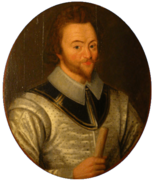Siege of Steenwijk (1580–1581) facts for kids
Quick facts for kids Siege of Steenwijk (1580–1581) |
|||||||
|---|---|---|---|---|---|---|---|
| Part of the Eighty Years' War & Anglo–Spanish War | |||||||
 The failed Spanish siege of Steenwijk under Count Rennenberg in 1580/1581, by Jan Luyken |
|||||||
|
|||||||
| Belligerents | |||||||
| Commanders and leaders | |||||||
| Strength | |||||||
| 1,200 (by December) | 6,000 infantry, 1,200 cavalry |
||||||
| Casualties and losses | |||||||
| Unknown | Heavy | ||||||
The Siege of Steenwijk was an important battle that happened between October 18, 1580, and February 23, 1581. It was part of two bigger wars: the Eighty Years' War and the Anglo–Spanish War. In this battle, a Spanish army tried to capture the town of Steenwijk in the Netherlands.
The Spanish forces were led by George van Lalaing, who had switched sides to join Spain. Inside Steenwijk, the town was defended by Dutch rebel soldiers under Johan van den Kornput. An English and Dutch rebel army, led by John Norreys, came to help the town. They successfully helped Steenwijk on January 24, 1581. Because of sickness and a lack of supplies, the Spanish army gave up the siege in February.
Why the Siege Happened
In March 1577, Spain sent soldiers from Wallonia (a region in present-day Belgium) to keep control of Overijssel. This was a province in the Netherlands that wanted to be free from Spanish rule.
By March 1580, many Protestant Dutch people were angry. This was because George van Lalaing, a powerful leader who used to be on their side, had joined Spain. The Spanish soldiers in Overijssel had not been paid. Because of this, they decided to switch sides and join the Dutch rebels.
Overijssel did not have many Dutch rebel soldiers. There was only one group led by Captain Olthof. But in October, another group of 600 soldiers arrived in Steenwijk. These soldiers were led by Johan van den Kornput. In 1578, Kornput had helped Lalaing during the Siege of Deventer. After that siege, the city of Deventer had to surrender to the Dutch rebels.
The Siege of Steenwijk
On October 18, 1580, the day after Kornput arrived in Steenwijk, the Spanish army began their attack. Lalaing led over 6,000 foot soldiers and 1,200 horsemen to surround Steenwijk.
In November, the Spanish fired many cannons at the town. This attack destroyed about seventy houses. The people in the city were already suffering because the harvest that year had been bad. The Dutch rebels tried to send help twice in late November, but the Spanish stopped them. So, the Dutch rebel leaders asked John Norreys for help. Norreys was in Brabant at the time. He was made a general and marched towards Steenwijk with two thousand men.
Norreys reached Steenwijk on December 15. His relief army was immediately attacked by the Spanish. There was a big fight along the Vledder Aa river. The English and Dutch rebels fought back and pushed the Spanish away. The defeated Spanish soldiers ran away, leaving behind their armor and other gear. Norreys quickly used this chance to break through the Spanish defenses. He brought supplies and more soldiers into Steenwijk. This help, even though it was only for a while, changed the whole battle.
The siege happened during winter, so both sides suffered a lot from the cold. The city canal and the Vledder Aa river froze over many times. This caused problems, as soldiers and cannons sometimes fell through the ice. On January 24, Norreys and his men made a surprise attack from the city. This attack was very important. They captured Spanish equipment, broke many of their cannons, and captured or killed nearly 400 Spanish soldiers.
By February 23, 1581, the Spanish army was in a terrible situation. Many soldiers, including Lalaing, were sick from the cold. They were also running out of food and ammunition. Lalaing knew he could not stay through the winter or win the battle. So, he gave up the siege and left with his men.
What Happened Next
Steenwijk survived the four-month siege because of Captain Johan van den Kornput's strong leadership. Also, the supplies brought by Captain Norreys helped the city avoid sickness. The Spanish army faced another defeat in July at Kollum. Norreys's troops chased and defeated them there, and Lalaing was killed. He was buried in the Martini Church in Groningen.
In November 1582, the Spanish returned, led by Juan Baptista de Tasis. Steenwijk was quickly captured, and the remaining Protestants left the city. Steenwijk became a Spanish stronghold, with only about fifty of its original people left. Only Zeeland, Utrecht, and Friesland remained in Dutch rebel hands. Soon, the Spanish army in Steenwijk, now led by Anthonie de Coquele, grew to over 1,000 men. These included soldiers from Spain, Italy, Wallonia, and Burgundy.
On May 28, 1592, Prince Maurice of Orange gathered an army of 8,000 men. He began to win back many areas for the Dutch. All roads to Steenwijk were blocked, and the city was under siege again. On July 5, 1592, after a fierce battle that lasted 44 days, the Spanish surrendered. By this time, Steenwijk was almost completely destroyed. It was not until 1597, after another failed attack by the Spanish, that the Dutch government found the money to rebuild the city's defenses and the city itself.
See also
 In Spanish: Sitio de Steenwijk (1580-1581) para niños
In Spanish: Sitio de Steenwijk (1580-1581) para niños


